Myth, Magic and the Transformation of Machu Picchu
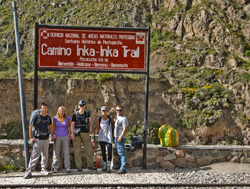
Hiking the Camino Inca to Machu Picchu should be a transformative experience. After all, I was treading the same stone steps that Inca kings and nobility had trod before the Spanish arrived. Think breath-taking heights (literally), panoramic views of the mountain tops, and struggling up steep grades through jungle and rain forest to get to the ‘Sun gate’ and finally peer down upon the fabled city of Machu Picchu. How can one not be transformed after an experience like that?
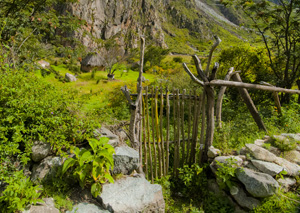
There were five of us – a thirty-something New Zealand/Irish couple and a twenty-something British couple – and me at almost twice their age. We started our trip at 4:30 in the morning, joining the small bus that took us to the small town of Ollantaytambo northwest of Cuzco, and then beyond to kilometer 82 on the railroad tracks between Cuzco and Aguas Calientes, the modern town that lies just below Machu Picchu. From there we took to the trail and entered the backcountry of the Sacred Valley of the Urubamba River. We hiked up a gently sloping trail past people bringing horses and burros down to the river, and to fields to pack out the recent potato crop. We were passed on the path by our red-clad porters who literally ran up the path ahead of us like the ‘Flash’, to get to our lunch time stop ahead of us and prepare a massive meal of trout and vegetables and potatoes and pasta. With that break we kept hiking, stopping at lookouts to see terraced remains of ancient Inca communities and the small farmsteads that exist today.

The ground started up and we aimed at our first pass – 4,200 meters, but stopped to camp for the night at Ayapata, about half way up the mountain flank. So we had a quiet evening listening to the frogs that sang into the night and looking at the southern cross and Orion’s belt hanging over the glaciers, both of which were important to the Incas. The Southern Cross apparently helped predict the growing seasons, as well as major events such as the destruction of the Inca Empire. Orion’s belt represented the three layers of the world that the Incas believed in.
Day 2 began with a great breakfast of fruit and pancakes, but it couldn’t allay the torture to come. This was the day we had to cross the 4,200 meter, appropriately named, ‘Dead Woman’s Pass’. They say the pass earned its name because from a distance the rock formations look like a woman’s breast and nipple and face. Okay, I could see that, but as I began the climb I could also see other possibilities.
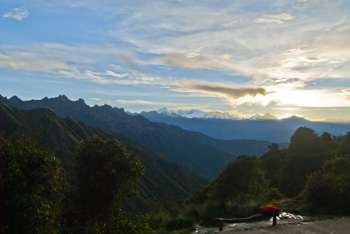
You see 4,200 meters makes it hard to breathe. You sweat and you climb uneven stairs and rocky paths and wind up through rough terrain, past old women driving llamas up the slope. Up and I was gasping and thanking god for the two walking sticks I had which, when I wasn’t climbing, I could lean on while I tried to find the oxygen to breath.
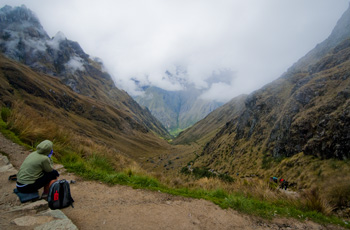
Finally, I made it to the top and the freezing wind cut through me and made me pull on all my layers of clothing before starting the difficult journey down.
Think steps and more steps, presumably created by people with a twisted, carnival-funhouse sense of evil. Treacherous and steep and uneven, but we made our way down into a lovely valley with waterfalls and rivers cascading alongside the path through thickening vegetation that became cloud forest thick with the scent of moisture and growing. We had lunch there and it was a matter of throwing ourselves on the ground in exhaustion, having lunch, and then having thirty minutes to rest before the rest of the day’s trek.
You see, we still had another pass to climb.
Upward, and the forest grew up around us, moist and filled with exotic species like bromeliads and orchids, and the trees were covered with moss and old lichen and birds flashed yellow and blue through the branches. The air was heavy and gradually clouds rolled in as we stopped at an old, round ruin, where our guide drew the Cuzco cross for us and told us how the shape represented much of the Inca universe, and how the Urubamba river valley ruins match many of the sacred constellations that the Inca saw in the sky; over-world and this world in harmony.
The rain started then. It washed away the guide’s drawing as we started for the next pass of 4,000 meters. Wearing slickers against the rain, we struggled up – or I did – did I mention that I’ve had knee surgery twice? But I kept slogging as the rain became hail and the guide finally sent the others on towards the next camp while he and I – finally made the top and took shelter in a cave while the downpour continued. That was the first magical moment of the hike. Sitting in semi-darkness while the rain ran down the rock steps and dripped from moss on the rocks and the frogs sang in happiness at the moisture.
And then there was more down. More steps, water-slicked this time, but after what seemed like forever we made camp and I literally just sagged to the ground. It was over. The worst of it was. I had made it over Dead Woman’s Pass and only felt like I was dead.
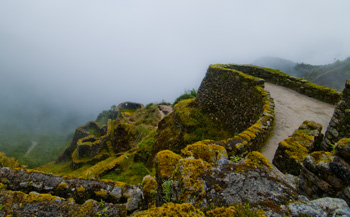
The next day involved crossing the third pass. It was much lower than the others and I could breathe as we started down the long string of stairs and rough paths through rain forest. As we went, we learned the names of the orchids, and saw how the elephant ear leaves are smaller near the peak and get larger as you go lower because the oxygen increases – which sort of explains why a coastal woman like me is sooo much taller than the people of the sacred valley.
At about 12:30 we had to choose: go to camp or go to nearby ruins. We chose the ruins of Huinay Huayna. Think a great arc of terraces built into a hillside so steep it would be hard to stand. Think jungle rainforest on all sides and we sat on the steps beside a trickling, ancient irrigation channel and looked out over the mountainside and the Urubamba far below. Butterflies, some black, some iridescent turquoise and yellow and translucent fragile, fluttered up around us dancing on the slight breeze. With the sun on our faces and the water music, that was the second magical moment of the trip.
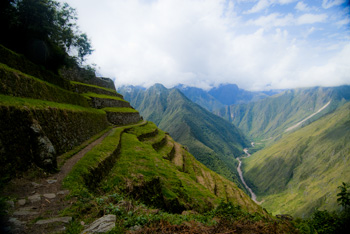
Frogs and cicadas welcomed our 3 am wakeup call the last morning. You see there is a race to get to the Intipunku – the Sun gate and we wanted to be the first out the checkpoint. We were, racing like ghosts by flashlight through pre-dawn darkness to the music of the frogs and cicadas, calling out treacherous footing to each other, struggling up fifty stairs that were almost perpendicular and then reaching the gate to be confronted by — cloud.
The myth is that on solstice days the sun comes through this gate and shines directly through one of the temple windows at Machu Picchu. The myth is that at Machu Picchu there are sacred stones that will fill you with energy if you touch them — but today these stones are cordoned off. The myth is that Machu Picchu exists as one of the few power places in the world, but standing there in the cloud it was easier to believe that Machu Picchu was like Xanadu and never really existed except in our hearts and our wishes. Magic.
Going down to cloud-shrouded Machu Picchu was the anticlimax. No longer is the ancient city a place seen by the very few who dare the ridges and passes of the Canimo Inca. Now busses bring the tourists up from Anguas Calientes every five minutes. Hordes of them, laughing, blabbing, yelling, irreverent, fat, sweaty and swearing tourists of every accent and nationality. There is no place you can go and feel the quiet of the place. There’s barely a place you can hear the birds sing. So I sat in Machu Picchu nursing sore legs and watched the clouds and mists roll over the mountains. I almost wished I had never left the sungate, or had had the chance to keep running the mountain passes seeking a city that never existed.
Unfortunately, the other transformation was the realization that, though my heart may be willing, physically, I’ve outrun my days of running ridges.
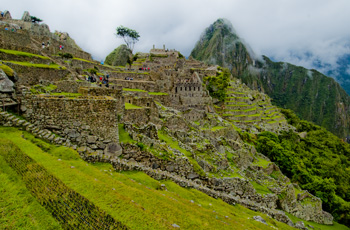










14 Replies to “Myth, Magic and the Transformation of Machu Picchu”
So glad you made it, and thanks for sharing your lovely adventure! Hope you get your pics on your next visit (although I love the photos you’ve put up so far!) I have found the mix of MP crowds at different times and different days makes for a very different experience. Enjoy!
Back? You’re going back?! Tell me you’re taking a bus this time.
Well, actually it is a train and a bus, but yes, I’m going back to try to get the photos I wasn’t able to get previously. Right now I’m sitting in a little one horse town at the end of the railway. I plan to do some exploring around here (legs permitting) and then tackle Machu Picchu on the 24th.
Beautiful, Karen! The pictures are amazing.
I must say, though, I rode one of the buses bringing tourists from the hotels in Aguas Calientes, and, yes, MP was crowded–I called it Peruvian Disneyland. A far cry from the Machu Picchu my parents visited in 1976. But we had one guide for two people, and after our two-hour tour my dh and I spent 6 additional hours climbing around MP on our own. We found places alone and listened to birds (and took pictures of them flitting in and out of rock hollows–and saw our first ever chincillas in some caves). I loved it! Tourism is the #3 industry in Peru, following agriculture and mining. For a place like MP to survive, it’s a necessary “evil” (for lack of a better word) and every one of us who visits there contributes to it. I can see how visiting MP following the arduous hike might be a let-down, but the beauty of the place is undeniable. I found it very surreal. Especially the mist! (we couldn’t see the sunrise due to cloud, either).
I’ve thoroughly enjoyed your adventures!
Cindy
Thanks, Cindy. I understand the importance of tourism to Peru, however it seemed that there was a particularly unruly mob the day I was there. Rude. Yelling. Talking so loud you couldn’t hear your own guide speak. People shoving in front of you as you are trying to take a photo. People disregarding the custodians of the place and climbing on walls or touching things they were specifically told not to touch. As a result, of that and being limited in my ability to climb away from the crowd by two strained ankles, I found it hard to see the beauty under the overlay of tourists. On a positive note, I am going back because I understand that the crowds end around 2 pm.
Hey Karen ~ Thank you so much for taking us all with you on your journey. Despite the letdown at the end, it still sounds like an absolutely marvelous adventure. Communing with butterflies on a Peruvian mountaintop doesn’t exactly suck, now does it?
I’m just happy to hear that you survived after your earlier troubles.
I also wanted to point out that ‘dead woman’s pass’ might have a different anatomical reference … but I’ve always been the smuttier of us two.
Come home safe,
B
Barb, I just wish you could have been here. Then at least I’d have had someone to make me laugh as I was crawling up the mountain.
And no, communing with butterfles was magic.
Ah, Karen, how lovely, and wonderful that you made it to the top. I feel your dismay at there not being the reverential silence the place deserves, and yet rejoice with you that the accomplishment is yours.
Can’t wait to see more of your pictures. Travel safely my friend. Rest well, and come home!
Karen F.
The transformative will have been in the journey and not the arrival – and I bet you’ll notice that more as you continue your trip…
What an accomplishment!
Hope you’ve booked a luxurious spa for the next few days.
Linda
>I’ve outrun my days of running ridges.<
Oh dear, does that mean you don't want to climb King's Peak with me this summer? It's only 4,123 m. Looking at the pictures you've taken, I don't think King's Peak is as steep of a climb as Machu Picchu except over the two passes and up the summit. I was going to invite you to come with me, because it would be fun. We're planning a 6 day 5 night 50 mile trip through the high Uintas, including summiting King's. That's the goal at least. I'm refusing to believe I'm too old for it.
I love these pictures you've taken of the climb. Wonderful, wonderful. Makes me want to be there with you. Thanks so much for sharing your experiences!!!!
Ahhhhhhhh – you did it! My heart sings and my legs ache just thinking about you sitting at the top of that pass!
Absolutely incredible and you brought your experience to life. I could just hear the happy, singing frogs, feel the burning in my lungs and muscles and feel the moisture.
I’m so happy for you!! What an adventure!! I wish I could’ve been with you, but I would’ve collapsed at Dead Woman Pass and given validity to its name. LOL.
Rest up!!
What an amazing experience, Karen. Part of me envies you (the other part is aghast). What I really want to know is, did you have to hike back?